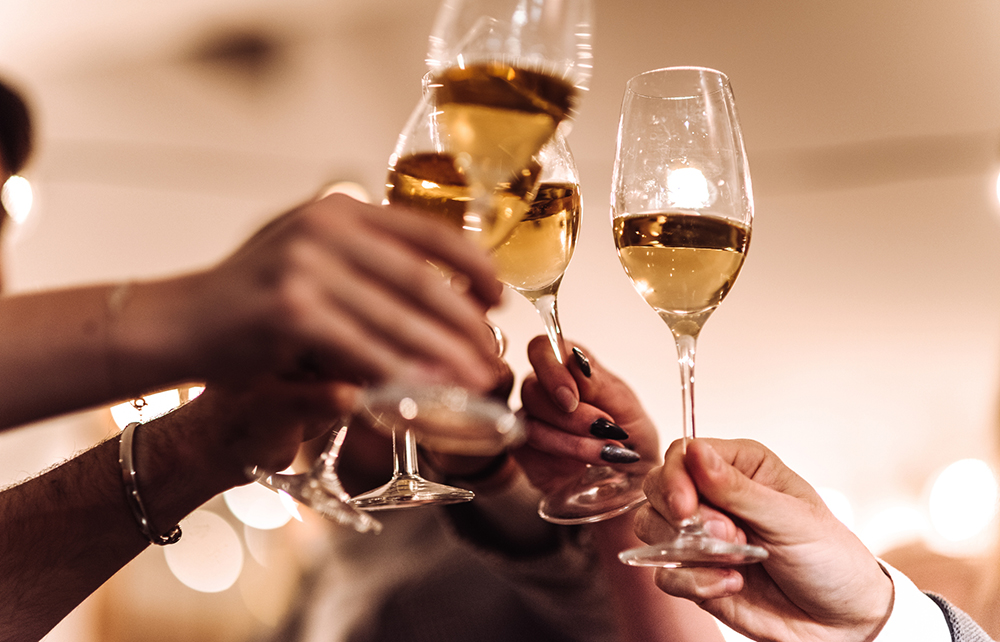‘I drink champagne when I’m happy and when I’m sad,’ Madame Lily Bollinger (1899-1977) remarked. ‘Sometimes I drink it when I’m alone. When I have company I consider it obligatory.’ As the last constituency results trickle in, we’ll all inevitably find ourselves in some combination of those four states.
If you’re sad, I hope at least you have good company – and that you’re as well supplied with the great French spirit-lifter as I have been this week, with a busload of Spectator readers on a tour to Reims, Epernay and Aÿ. But I suspect you’ve also consumed more than enough media comment on the spectacle of second-rate politicians slime-wrestling, dog-whistling and lying about tax plans. And given that the elections at home and in France have temporarily knocked business out of the news, I hope you’ll forgive me if I slip my harness for once and offer a column that’s about (almost) nothing but champagne.
Seduction technique
I mean, of course, champagne as a case-study of resilient entrepreneurship and brand projection, whatever the changes of political and physical climate: I’m not just going to boast about how much I’ve been drinking. But I’ll start by admitting that after tasting 40 wines in four days, I cannot claim an expert’s palate. I preferred, for example, the slightly nutty Henri Chauvet Brut Blanc de Noirs (£29.95 in the UK) over Bollinger’s supposedly fabulous La Côte aux Enfants 2012 (£1,060 – yes, that’s per bottle). Does that make me a rosbif vulgarian, or is it a perfect illustration of the myth-making that gives champagne its commercial power?
La Côte aux Enfants is ‘the realisation of the visionary spirit of Jacques Bollinger’, who was Lily’s husband. The Blanc de Noirs is the unspun product of the fourth–generation Damien Chauvet and his wife Mathilde, from a tiny cellar under their home in the village of Rilly la Montagne. If taste variations in this game are small and subjective, price differentials can be huge – and all about image.
Bollinger likes to associate itself with James Bond, rather than its other famous British customers such as Patsy from AbFab. The giant producer Moët et Chandon, part of the LVMH luxury goods group, is all about shameless bling. Pol Roger makes great mileage out of the factoid that Winston Churchill drank the lifetime equivalent of 42,000 of its bottles. Every house has its high-flown patter about the spirit of each wine. And by the time you reach the 40th, you know much of it is hogwash – but clever hogwash that makes drinkers feel good and protects champagne against allcomers in the wider world of wine. It’s the most brilliant seduction technique: businesses in every sector everywhere should learn from it.
Beau monde
Bizarrely, we saw almost nothing of the French election: barely a placard, no street campaigning, only a desultory protest by farmers (with very expensive tractors) outside Reims town hall. Brasseries were buzzing – I recommend Boulingrin in Reims for authenticity and La Banque in Epernay because I like eating in repurposed banking halls – but I did not sense that diners were deep in political debate; the only television footage of voting-related violence came from the Pacific outpost of New Caledonia. As for French interest in UK politics, there was none at all, unless we count a startlingly good impersonation – by a salesman for the house of Brimoncourt – of Boris Johnson.
Brimoncourt is an old champagne label recently revived in Aÿ by Alexandre Cornot, a former tax lawyer and naval officer. His brand emphasis is on stylish informality and his target market is the Parisian beau monde and its British equivalent, well represented by our bus party. I asked him what it’s like to be an entrepreneur in a sector dominated by established grandees, under the burden of regulation that afflicts all smaller French companies. The collective image of champagne on which the big houses spend so massively is actually helpful to start-ups too, he says. But as for red tape and employment law: ‘It’s all the time as though someone else has his foot on your brake pedal.’
Sparkling future?
That made me think about the more than 100 sparkling wine ventures that have sprung up in England over the past 30 years or so – including two that are offshoots of the champagne houses Taittinger and Pommery. The rising quality of English wine is well recognised, but will the fledgling industry ever spin a collective sales pitch to match the eloquent self-confidence of the French?
Observing that Chapel Down, the largest English producer, has recently floated its shares on the Aim market, I also can’t help but wonder whether our native wine entrepreneurs will be tempted – like many of their peers in digital technology and bioscience – to head for a relatively swift cash exit, rather than following the ‘patient capital’ model of multi-generation champagne dynasties.
But there’s a much more pressing question for today: whether a new government is about to impose oppressive new layers of regulation on every promising pocket of British innovation, including the booze sector. Writing in the Financial Times, the former cabinet secretary Gus O’Donnell cites as an example of smart deregulation the 2007 repeal of the restrictive 1751 Gin Act, which has stimulated a vast number of gin-brand start-ups. He goes on to suggest the creation of ‘an independent Innovation Unit’ within government to promote ‘forward thinking’ and ‘help identify barriers’ to the sort of business development that will address ‘the UK’s dismal productivity record’.
Behind O’Donnell’s careful mandarin language, his meaning was plain: don’t let incoming ministers stifle entrepreneurship. I raise my glass to that message – and raise it again, swiftly refilled in the Lily Bollinger spirit, to Spectator conviviality whatever the new era may bring.








Comments